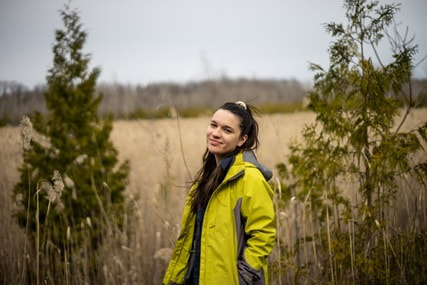Principal Investigator
Jonathan Cohen, Ph.D.
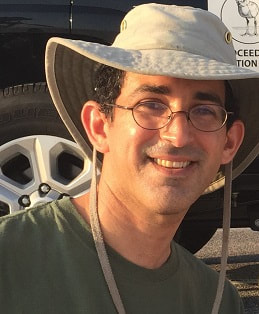
From early in my career I have been dedicated to the idea of making a positive difference while doing work that I enjoy. My research goal is to provide conservation agencies and organizations with a better understanding of factors that affect their ability to successfully manage wildlife populations. Although this is a very applied approach, there are often new and interesting discoveries to be made in each situation about species-habitat relationships and population drivers. Being a generalist, I always look for exciting opportunities to work with new species in new environments. I try to integrate my courses into my overall program, incorporating my research experience into my lectures and labs to try and keep my classes current and developing classes to enhance the research skills of my students. At the same time, I have been able to apply insights gained during course development and teaching to my research.
I view graduate students as junior colleagues. My aim is to provide them with a basic project framework typically based on an identified conservation need, funding support, and mentoring. I expect them to participate in the creative development of their projects, to bring new ideas and approaches to the table for discussion, and to join in the collegial spirit of the lab. Through discussion and readings we work together to stay current on the latest field and quantitative methods. Beyond daily interaction, this also means group travel to national and international meetings to meet scientists outside of our program and to gain experience presenting their findings. I look forward to working with students who display curiosity, creativity, and an interest in scholarship.
Education
Ph.D. Fisheries and Wildlife Sciences, Virginia Tech, 2005
M.S. Renewable Natural Resources, University of Connecticut, 1998
B.S. Natural Resources, Cornell University, 1994
Curriculum Vitae
I view graduate students as junior colleagues. My aim is to provide them with a basic project framework typically based on an identified conservation need, funding support, and mentoring. I expect them to participate in the creative development of their projects, to bring new ideas and approaches to the table for discussion, and to join in the collegial spirit of the lab. Through discussion and readings we work together to stay current on the latest field and quantitative methods. Beyond daily interaction, this also means group travel to national and international meetings to meet scientists outside of our program and to gain experience presenting their findings. I look forward to working with students who display curiosity, creativity, and an interest in scholarship.
Education
Ph.D. Fisheries and Wildlife Sciences, Virginia Tech, 2005
M.S. Renewable Natural Resources, University of Connecticut, 1998
B.S. Natural Resources, Cornell University, 1994
Curriculum Vitae
| curriculum_vitae_cohen_2023.pdf | |
| File Size: | 349 kb |
| File Type: | |
Graduate Students and Post-Docs
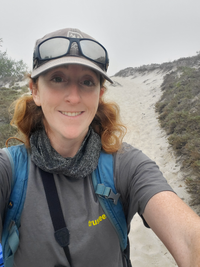
Molly Picillo, Ph.D. Student
I am a PhD student in the Cohen Lab at SUNY ESF studying the imperiled New England cottontail (NEC). In New York, NEC are present east of the Hudson River, in Columbia, Dutchess, Putnam, and Westchester counties. My research will provide an estimate of abundance for NEC in these areas and I aim to create a population model for the future management of the species. This research will be carried out with the support from the New York Department of Environmental Conservation.
Prior to joining the lab, I received my B.S. in Zoology and Wildlife Ecology in 2016 from the University of Maine. I returned to UMaine and obtained an M.S. in Teaching in 2018 in which I carried out a research-based thesis on science literacy. I applied these degrees as an AmeriCorps member for the Maine Department of Agriculture, Conservation and Forestry where I created a trail inventory system for state parks and public lands across Maine. Following this, I spent two years in Texas researching the endangered ocelot and working on an underpass system to help reduce wildlife road mortalities. My vested interests are in conservation and management of imperiled, threatened, and endangered species. I aim to leverage my teaching education to help make research more accessible to everyone interested in conservation efforts.
I am a PhD student in the Cohen Lab at SUNY ESF studying the imperiled New England cottontail (NEC). In New York, NEC are present east of the Hudson River, in Columbia, Dutchess, Putnam, and Westchester counties. My research will provide an estimate of abundance for NEC in these areas and I aim to create a population model for the future management of the species. This research will be carried out with the support from the New York Department of Environmental Conservation.
Prior to joining the lab, I received my B.S. in Zoology and Wildlife Ecology in 2016 from the University of Maine. I returned to UMaine and obtained an M.S. in Teaching in 2018 in which I carried out a research-based thesis on science literacy. I applied these degrees as an AmeriCorps member for the Maine Department of Agriculture, Conservation and Forestry where I created a trail inventory system for state parks and public lands across Maine. Following this, I spent two years in Texas researching the endangered ocelot and working on an underpass system to help reduce wildlife road mortalities. My vested interests are in conservation and management of imperiled, threatened, and endangered species. I aim to leverage my teaching education to help make research more accessible to everyone interested in conservation efforts.
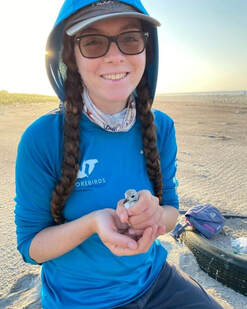
Alison Schroeder, MS Student (co-advised with Dr. Matthew Schlesinger)
I joined Dr. Cohen’s lab at ESF as an M.S. student in Conservation Biology in the Fall of 2022.
My research in this lab focuses on the effectiveness of using Autonomous Recording Units
(ARUs) for monitoring forest birds in locations that are difficult for humans to access on a
regular basis. This research will be conducted at Fort Drum Military Base, and will involve
collaboration with the New York Natural Heritage Program, Fort Drum Environmental
Division, and the lab of Dr. Jeffrey Larkin at Indiana University of Pennsylvania.
I received my bachelor’s degree in Environmental Studies from Adelphi University in 2020,
where I started my interdisciplinary journey into the environmental field. In 2017, I conducted
research on coral bleaching on the Great Barrier Reef, and presented my findings at Adelphi
University's 15th Annual Research Conference. As part of the Honors College, I completed a senior thesis on the importance of ecofeminism and vegetarianism in addressing environmental concerns.
My first fieldwork position was at Caumsett State Historic Park Preserve on Long Island in 2021, where I monitored and collected data of Piping Plover nesting and reproductive success. This job led me to my next position as a field survey technician for Environmental Design and Research over the winter of 2021 - 2022. I engaged heavily in raptor point counts for state-listed species
(Short-eared Owls and Northern Harriers), and used ArcGIS applications for data collection. My most recent (and most rewarding) field position was as a research technician for Virginia Tech over the summer of 2022. This opportunity gave me extensive experience in Piping Plover banding and nest searching. I have also volunteered at a wildlife rehabilitation center, farm, and bird sanctuaries. In my spare time, I enjoy reading, dancing, hiking, and birdwatching. I hope to use my time at ESF to prepare myself for a career in wildlife/habitat conservation and management.
I joined Dr. Cohen’s lab at ESF as an M.S. student in Conservation Biology in the Fall of 2022.
My research in this lab focuses on the effectiveness of using Autonomous Recording Units
(ARUs) for monitoring forest birds in locations that are difficult for humans to access on a
regular basis. This research will be conducted at Fort Drum Military Base, and will involve
collaboration with the New York Natural Heritage Program, Fort Drum Environmental
Division, and the lab of Dr. Jeffrey Larkin at Indiana University of Pennsylvania.
I received my bachelor’s degree in Environmental Studies from Adelphi University in 2020,
where I started my interdisciplinary journey into the environmental field. In 2017, I conducted
research on coral bleaching on the Great Barrier Reef, and presented my findings at Adelphi
University's 15th Annual Research Conference. As part of the Honors College, I completed a senior thesis on the importance of ecofeminism and vegetarianism in addressing environmental concerns.
My first fieldwork position was at Caumsett State Historic Park Preserve on Long Island in 2021, where I monitored and collected data of Piping Plover nesting and reproductive success. This job led me to my next position as a field survey technician for Environmental Design and Research over the winter of 2021 - 2022. I engaged heavily in raptor point counts for state-listed species
(Short-eared Owls and Northern Harriers), and used ArcGIS applications for data collection. My most recent (and most rewarding) field position was as a research technician for Virginia Tech over the summer of 2022. This opportunity gave me extensive experience in Piping Plover banding and nest searching. I have also volunteered at a wildlife rehabilitation center, farm, and bird sanctuaries. In my spare time, I enjoy reading, dancing, hiking, and birdwatching. I hope to use my time at ESF to prepare myself for a career in wildlife/habitat conservation and management.
Maureen Durkin, M.S. (Ph.D. Candidate)
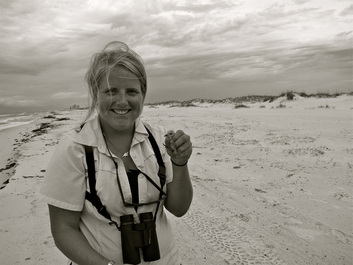
As an M.S. student at SUNY ESF, my research focused on the impacts of anthropogenic disturbance on Snowy Plovers in the Florida Panhandle. Due to rapid coastal development in the region and the popularity of Snowy Plovers' beach habitats for human recreation, this species is listed as threatened in Florida. From 2011-2012, I monitored marked Snowy Plovers in the Panhandle to determine reproductive success, and measured behavioral responses to disturbance. This information will aid managers in the region in determining effective buffer distances for breeding areas and in making decisions regarding disturbance mitigation strategies.
After I received my M.S. degree, I opted to continue working with Snowy Plovers for my PhD research. My dissertation research is focused factors limiting local and regional Snowy Plover populations in the Florida Panhandle, and using mark-recapture methods to quantify shorebird and other wildlife mortality from vehicle collisions on roadways. I completed a pilot season of fieldwork for our road mortality study in 2013, and continued with Snowy Plover monitoring and carcass surveys on roadways in the park in 2014-2016.
I graduated from Connecticut College in 2008 with a B.A. in Biological Sciences and a minor in Anthropology. I spent a semester of my undergrad in Kenya taking courses in a wildlife management program and learning field techniques during a project on the environmental and social impacts of rangeland degradation. Before returning to school for my M.S., I held field positions working with Sandhill Cranes in Mississippi and Wisconsin, monitoring breeding shorebirds in Florida, and conducting wintering shorebird surveys in south Texas. When not doing science, I enjoy traveling, birdwatching, growing plants, embroidery, and spending time with my husband and our two retired racing greyhounds.
After I received my M.S. degree, I opted to continue working with Snowy Plovers for my PhD research. My dissertation research is focused factors limiting local and regional Snowy Plover populations in the Florida Panhandle, and using mark-recapture methods to quantify shorebird and other wildlife mortality from vehicle collisions on roadways. I completed a pilot season of fieldwork for our road mortality study in 2013, and continued with Snowy Plover monitoring and carcass surveys on roadways in the park in 2014-2016.
I graduated from Connecticut College in 2008 with a B.A. in Biological Sciences and a minor in Anthropology. I spent a semester of my undergrad in Kenya taking courses in a wildlife management program and learning field techniques during a project on the environmental and social impacts of rangeland degradation. Before returning to school for my M.S., I held field positions working with Sandhill Cranes in Mississippi and Wisconsin, monitoring breeding shorebirds in Florida, and conducting wintering shorebird surveys in south Texas. When not doing science, I enjoy traveling, birdwatching, growing plants, embroidery, and spending time with my husband and our two retired racing greyhounds.
Undergraduates
Lab Alumni
Cameron Fiss (Ph.D. 2023)
Current Position: Post-doc, University of Pittsburgh
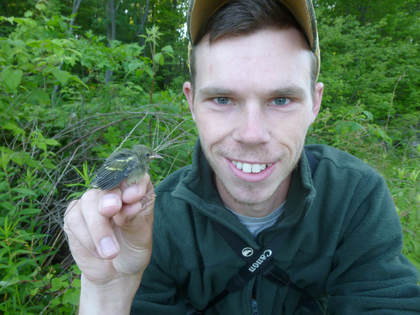
I joined the Cohen lab at ESF in the Fall of 2018. I am broadly interested in forest management and how wildlife responds to management across different spatial and temporal scales. My PhD research focuses on examining individual and community responses of songbirds to forest management occurring across Western Pennsylvania at landscape and site-level scales. This research is driven by the fact that deciduous forest health is declining nationwide and many of our remaining forests are severely degraded due to invasive forest pests, high deer abundances, historical suppression of natural disturbances, and human development. As such, forests such as those in Appalachia are often fragmented, and lack both within stand structural complexity as well as age class diversity. Many of our iconic forest-dependent songbird species are declining, at least in part, because of these changes. Through my research I hope to better understand factors driving reproductive success of Wood Thrush (Hylocichla mustelina), how management influences streamside avian communities, and evaluate the effectiveness of private lands forest management for target species.
I received my B.S. in Biology from Indiana University of Pennsylvania (IUP) in 2014 and my MSc at IUP in 2018. Before beginning my master’s research, I was fortunate enough to work as a technician on a project which assessed the value of silviculturally derived habitat for Golden-winged Warblers (Vermivora chrysoptera) relative to naturally occurring wetlands. This work allowed me to quickly transition into my thesis research which focused on post-fledging ecology of Golden-winged Warblers in the Appalachians. Specifically, I investigated how juvenile Golden-winged Warblers selected for habitat in managed forests of Pennsylvania. I have also been fortunate enough to work on or conduct research related to American Woodcock (Scolopax minor), Eastern Whip-poor-will (Antrostomus vociferus), and Prairie Warbler (Setophaga discolor), in varying capacities. During my free time I enjoy travelling, cooking, camping, and generally being outdoors.
I received my B.S. in Biology from Indiana University of Pennsylvania (IUP) in 2014 and my MSc at IUP in 2018. Before beginning my master’s research, I was fortunate enough to work as a technician on a project which assessed the value of silviculturally derived habitat for Golden-winged Warblers (Vermivora chrysoptera) relative to naturally occurring wetlands. This work allowed me to quickly transition into my thesis research which focused on post-fledging ecology of Golden-winged Warblers in the Appalachians. Specifically, I investigated how juvenile Golden-winged Warblers selected for habitat in managed forests of Pennsylvania. I have also been fortunate enough to work on or conduct research related to American Woodcock (Scolopax minor), Eastern Whip-poor-will (Antrostomus vociferus), and Prairie Warbler (Setophaga discolor), in varying capacities. During my free time I enjoy travelling, cooking, camping, and generally being outdoors.
Natia Javakhishvili (MS 2023) (co-advised with Dr. Jeff Larkin)
Current Position: Ph.D. Student, Oregon State University
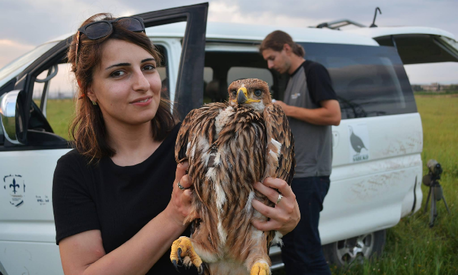
I joined the Cohen lab at ESF as an M.S. student in Conservation Biology in the Fall of 2021. My interest has always been in researching endangered bird species, their distribution, habitat use and selection, extinction rates and other population parameters. My research focuses on using new techniques, such as acoustic monitoring, for assessing the distribution of the breeding population of Broad-winged hawks (Buteo platypterus) in Pennsylvania and its relationship to forest management.
Surveying the raptor species and their breeding areas is often a core component of various landscape restoration projects, biodiversity monitoring schemes, or environmental impact assessments. The study of birds of prey is often limited by their wide spatial distribution and low numbers of breeding pairs. However, a growing number of studies are proposing to deploy autonomous recording devices and create sound classifiers as a new and efficient technique for surveying raptors with low-impact on the birds. Accordingly, the focus of my research and master thesis will be studying different ecological characteristics of Broad-winged Hawks in Pennsylvania by using the data collected from ARUs distributed within the forests and camera traps located on the nests. I hope my research results in the following: (1) confirming the system’s applicability as a survey method (2) development of sound classifiers of Broad-winged hawks for both adults and chicks (3) Creation occupancy models for Broad-winged hawks for Pennsylvania and assessment the distribution of breeding pairs.
I received my bachelor's degree in biology from Tbilisi State University in Georgia in 2015 and my master's degree in ecology in 2017 from Ilia State University, where my research was focused on Eastern Imperial Eagle movement, home range, and habitat selection based on satellite data. My work experience covers both the governmental and non-governmental sectors.
During the past four years, I have been leading Sabuko, a Birdlife partner organization in Georgia, where I have had the opportunity to lay the groundwork for the conservation of endangered species such as the Egyptian vulture (Neophron percnopterus) and Eastern Imperial (Aquila heliaca) eagle, as well as the restoration of degraded semi-arid landscapes and surrounding floodplain forests. In the future, I plan to continue working in the field of wildlife research and conservation.
Alison Kocek (MS 2016, Ph.D. 2021), Postdoctoral Research Associate
Current Position: Biologist, U.S. Fish and Wildlife Service Coastal Program
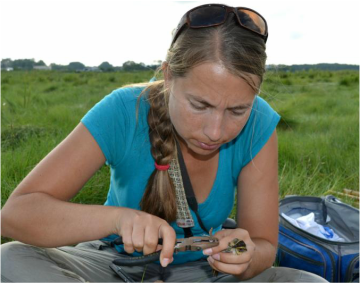
I joined the Cohen lab as an M.S. student in Fish and Wildlife Biology & Management in 2012 where I studied factors impacting tidal marsh sparrow nesting presence and nest survival in an urban environment of New York City which I completed in 2016. My research examined differences in habitat characteristics (e.g. vegetation make-up, prey abundance, disturbance events) of marshes containing nesting saltmarsh sparrows (Ammodramus caudacutus) and seaside sparrows (Ammodramus maritimus) in marshes throughout New York City and surrounding Long Island, NY with marshes historically containing nesting birds but where they no longer persist. I also examined nest survival and how tidal marsh characteristics impact survival within an urban environment.
This initial study uncovered evidence of previously-undocumented variability in nest substrate use for saltmarsh sparrows indicating that tidal marsh sparrows may be more plastic in selection of nest sites than previously believed. This important finding may have impacts on persistence time of this species in the face of sea level rise and led me to pursue my Ph.D. research within the same study system where I will seek to discover processes by which individuals and populations of tidal marsh sparrows adjust to a changing environment. The focus of this study will be to better understand how individual nest building behaviors vary with causes of nest loss, what factors impact densities of nesting tidal marsh sparrows, and how inaccuracies in nest fate and survival estimates can be refined with novel field techniques (i.e. iButtons, RFID technology, and radio transmitters). This study is expected to provide guidance to land managers of tidal marsh ecosystems on restoration designs that may especially suitable for nesting tidal marsh sparrows as these birds are expected to go extinct by 2050 without intervention.
Prior to joining the Cohen lab, I attend the University of Arizona where I obtained my B.S. degree in Ecology and Evolutionary Biology in 2004. I then held field positions working on Montezuma Quail abundance and survival in Patagonia, AZ for Texas A&M; researching and managing active seabird nesting colonies and running a spring banding station in coastal ME for National Audubon Society’s Seabird Restoration Program; running a fall neotropical migrant and shorebird banding station on Petit Manan Island, ME for USFWS; studying Red Knot stopover ecology on the eastern shore of VA for Virginia Tech; supervising a crew studying effects on wintering Piping Plover post Deepwater Horizon Oil Spill in Grand Isle, LA for Virginia Tech; and leading a crew studying the demographics of breeding Piping Plover on the Missouri River in Yankton, SD for Virginia Tech. In my spare time I enjoy birdwatching, reading, serving as President of Onondaga Audubon, and raising freshwater aquarium shrimp.
This initial study uncovered evidence of previously-undocumented variability in nest substrate use for saltmarsh sparrows indicating that tidal marsh sparrows may be more plastic in selection of nest sites than previously believed. This important finding may have impacts on persistence time of this species in the face of sea level rise and led me to pursue my Ph.D. research within the same study system where I will seek to discover processes by which individuals and populations of tidal marsh sparrows adjust to a changing environment. The focus of this study will be to better understand how individual nest building behaviors vary with causes of nest loss, what factors impact densities of nesting tidal marsh sparrows, and how inaccuracies in nest fate and survival estimates can be refined with novel field techniques (i.e. iButtons, RFID technology, and radio transmitters). This study is expected to provide guidance to land managers of tidal marsh ecosystems on restoration designs that may especially suitable for nesting tidal marsh sparrows as these birds are expected to go extinct by 2050 without intervention.
Prior to joining the Cohen lab, I attend the University of Arizona where I obtained my B.S. degree in Ecology and Evolutionary Biology in 2004. I then held field positions working on Montezuma Quail abundance and survival in Patagonia, AZ for Texas A&M; researching and managing active seabird nesting colonies and running a spring banding station in coastal ME for National Audubon Society’s Seabird Restoration Program; running a fall neotropical migrant and shorebird banding station on Petit Manan Island, ME for USFWS; studying Red Knot stopover ecology on the eastern shore of VA for Virginia Tech; supervising a crew studying effects on wintering Piping Plover post Deepwater Horizon Oil Spill in Grand Isle, LA for Virginia Tech; and leading a crew studying the demographics of breeding Piping Plover on the Missouri River in Yankton, SD for Virginia Tech. In my spare time I enjoy birdwatching, reading, serving as President of Onondaga Audubon, and raising freshwater aquarium shrimp.
Jordan Elliot (MPS 2022)
Current Position: : Excelsior Fellow, NYS Department of Parks, Recreation, and Historic Preservation Climate Change Action Committee.

Hello! I’m Jordan Elliott. I received a bachelor’s of Wildlife Science in 2020 from ESF and I returned in the fall of 2021 for a Masters of Professional Studies in Ecology! I plan to couple that M.P.S with a Masters of Public Administration from Syracuse University. My goal is to use my science background to inform policy and management in the public sector. I aim to have a good generalist knowledge of most aspects of terrestrial ecology to facilitate broad spectrum management. I also have a background in statistics, and I have been working with some ESF labs on data processing and analysis.
Drew Eline (MS 2021)
Current Position: Biologist, U.S. Forest Service
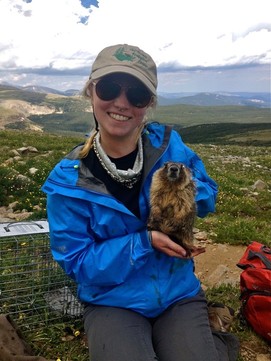
I had the opportunity to work on the New England cottontail project with the Cohen lab a few years back, so when the chance to become a graduate student for it came up, it was only natural to jump right in. My research is focused on assessing the impact of habitat management on the New England cottontail, a species of concern here in New York. The New England cottontail is an early successional (shrubland) obligate species that has experienced significant habitat loss due to forest maturation. Other factors such as the presence of eastern cottontails and invasive plant species could also be limiting the success of the species. My research will look at habitat use and survival of New England and eastern cottontails in areas where habitat management has been provided. Results of this study will aid managers in providing appropriate habitat management for the species, which can ideally encourage the presence of New England cottontails without encouraging eastern cottontails.
Before joining the lab, I grew up in Pennsylvania and attended Juniata College. Upon graduating in 2016 with a B.S. in wildlife conservation, I worked several field jobs. I have designed and carried out a study on scent marking in yellow-bellied marmots at the CU-Boulder Mountain Research Station’s REU; researched home range and habitat use of wood turtles in central PA as my undergraduate work; assisted in studying the ecology of Eastern whip-poor-wills in upstate New York for the University of Massachusetts-Amherst; worked with the Cohen lab on the ecology of New England cottontails; conducted a mark recapture study of endangered Northern Idaho ground squirrels looking at effects of habitat management and factors limiting their success for the University of Idaho; and aided in studying the ecology of Appalachian cottontails in western North Carolina for Virginia Tech. After these experiences, I came to understand that my research interests focus on the conservation of species of concern, especially understudied small mammals. I also have interest in how the behavioral ecology of a species can benefit their management.
When not doing science-y things, I enjoy reading, hand embroidery, being outdoors, making delicious popcorn, and petting all the cats and dogs. Oh, and gushing over all species of squirrel!
Before joining the lab, I grew up in Pennsylvania and attended Juniata College. Upon graduating in 2016 with a B.S. in wildlife conservation, I worked several field jobs. I have designed and carried out a study on scent marking in yellow-bellied marmots at the CU-Boulder Mountain Research Station’s REU; researched home range and habitat use of wood turtles in central PA as my undergraduate work; assisted in studying the ecology of Eastern whip-poor-wills in upstate New York for the University of Massachusetts-Amherst; worked with the Cohen lab on the ecology of New England cottontails; conducted a mark recapture study of endangered Northern Idaho ground squirrels looking at effects of habitat management and factors limiting their success for the University of Idaho; and aided in studying the ecology of Appalachian cottontails in western North Carolina for Virginia Tech. After these experiences, I came to understand that my research interests focus on the conservation of species of concern, especially understudied small mammals. I also have interest in how the behavioral ecology of a species can benefit their management.
When not doing science-y things, I enjoy reading, hand embroidery, being outdoors, making delicious popcorn, and petting all the cats and dogs. Oh, and gushing over all species of squirrel!
Alex Cook (MS 2021)
Current Position: Refuge Manager, Southern Oregon Coast National Wildlife Refuges
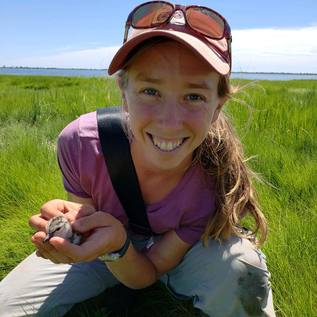
Originally from Massachusetts, I received my undergraduate degree in wildlife ecology and management from the University of Massachusetts- Amherst. Growing up on Cape Cod instilled me with a love of coastal ecosystems. I took this passion for the coast with me to work on many shorebird projects before joining the Cohen lab. I’ve always loved birds and have spent time all over the country and globe working with a variety of species including, common terns, piping plovers, snowy plovers and the white fronted plover of South Africa. More recently I have begun to work with songbirds. Volunteering at banding stations and working with overwintering warbler species in Jamaica has provided me with a great deal of experience. When not looking at birds for my job, I enjoy cooking, hiking, running and continuing to look at birds, just a little less intensely.
I began working for the Cohen lab as a snowy plover field technician in Florida during the summers of 2014 and 2015. In 2018 I began my MS working with breeding tidal marsh sparrows in NYC and Long Island. Salt marsh sparrows (Ammospiza caudacutus) and their nesting habitat are highly imperiled and they are are currently under review to be listed as a federally endangered species. The goal of my research is to monitor the effects of a thin layer sediment restoration project taking place in Queens, NY. We aim to monitor the response of salt marsh and seaside sparrows (Ammospiza maritimus) to this form of marsh restoration. This type of restoration project is one of the first of its kind and we hope to determine its benefits to marsh nesting species. In addition, we will also monitor nest survival and basic demographics of salt marsh and seaside sparrows at three different nesting sites. This will allow us to compare the breeding success and vegetation composition differences between marshes with an urban fringe and a more pristine marsh on an island.
I began working for the Cohen lab as a snowy plover field technician in Florida during the summers of 2014 and 2015. In 2018 I began my MS working with breeding tidal marsh sparrows in NYC and Long Island. Salt marsh sparrows (Ammospiza caudacutus) and their nesting habitat are highly imperiled and they are are currently under review to be listed as a federally endangered species. The goal of my research is to monitor the effects of a thin layer sediment restoration project taking place in Queens, NY. We aim to monitor the response of salt marsh and seaside sparrows (Ammospiza maritimus) to this form of marsh restoration. This type of restoration project is one of the first of its kind and we hope to determine its benefits to marsh nesting species. In addition, we will also monitor nest survival and basic demographics of salt marsh and seaside sparrows at three different nesting sites. This will allow us to compare the breeding success and vegetation composition differences between marshes with an urban fringe and a more pristine marsh on an island.
Amanda Cheeseman (Ph. D. 2017, Post-doc 2018-2021)
Current Position: Assistant Professor, South Dakota State University
Current Position: Assistant Professor, South Dakota State University
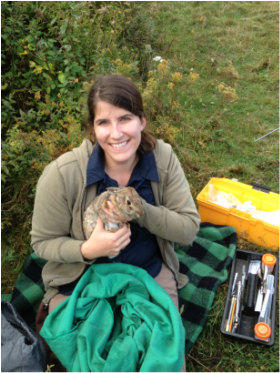
I finished my Ph.D. in August 2017 with Dr. Jonathan Cohen at SUNY ESF. I have continued to work with Dr. Cohen as a post-doc. My research focus is on underrepresented mammals of conservation interest. Here at ESF, I am studying the ecology of the declining New England cottontail, and its responses to the introduced eastern cottontail. As an early successional obligate species, it is thought recent range contractions in the New England cottontail are due to the progressive loss of early successional habitat as it matures into forest. Additionally, it is thought presence of eastern cottontails might inhibit re-colonization of suitable habitat patches. Using genetics and telemetry, I will be examining the impacts of eastern cottontails on New England cottontail habitat associations, survival, and dispersal in the Hudson Valley, NY. Results from this study will help inform managers about the ecology of New England cottontails in New York and aid in recovery planning and habitat restoration efforts for this species.
Originally from Michigan, I received my B.S. from Michigan State University before obtaining my M.S. from Fort Hays State University in Kansas. My M.S. research used stable isotope analysis to investigate diet change as a hypothesis for the decline of the eastern spotted skunk. Between my M.S. and Ph.D. Ph.D., I assisted studies examining the effects of mesocarnivore occupancy on lyme disease prevalence and use of metabarcoding techniques to determine site occupancy by using biting fly sampling. After matriculating, I hope to continue research and teaching as a professor. When not working, I enjoy reading fiction and playing with my Australian cattle dog, Brisbane.
Originally from Michigan, I received my B.S. from Michigan State University before obtaining my M.S. from Fort Hays State University in Kansas. My M.S. research used stable isotope analysis to investigate diet change as a hypothesis for the decline of the eastern spotted skunk. Between my M.S. and Ph.D. Ph.D., I assisted studies examining the effects of mesocarnivore occupancy on lyme disease prevalence and use of metabarcoding techniques to determine site occupancy by using biting fly sampling. After matriculating, I hope to continue research and teaching as a professor. When not working, I enjoy reading fiction and playing with my Australian cattle dog, Brisbane.
Michelle Stantial (MS 2014, Ph.D. 2020)
Current Position: Chief Scientist, Yosemite National Park, National Park Service
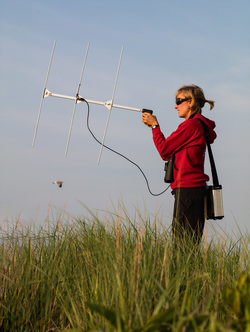
As a Ph.D. student my interests include predator-prey relationships, population dynamics, species interactions, and conservation. My current project will examine the factors limiting reproductive success of piping plovers (Charadrius melodus) in southern New Jersey. The Atlantic coast population of piping plovers has more than doubled since 1986 due to intensive management efforts across the breeding range. However, the New Jersey population has remained at approximately 100 pairs since listing, despite recovery actions taken by wildlife agencies. The goal of the project will be to make specific management recommendations that will maximize ideal piping plover breeding habitat and minimize the effects of predation and human disturbance.
I completed my M.S. at SUNY-ESF in December 2014, working on a project that examined piping plover flight behavior during the breeding season. The development of wind power in coastal areas poses a potential threat of collision mortality that could reverse the coast-wide population increase by piping plovers. This project was designed to quantify flight behavior and utilize an existing collision risk model in order to evaluate the potential impacts of building turbines at or near piping plover breeding sites.
I have been working with piping plovers since 2008 with several organizations including the U.S. Fish and Wildlife Service, the Massachusetts Audubon Society, Virginia Tech and the Tuckernuck Land Trust. I also have experience working with a variety of other species of birds including osprey, Northern harriers, American oystercatchers, black skimmers, red knots, and common, roseate, and least terns. When not spending time looking at birds, some of my favorite things are hanging out with my chickens, listening to NPR, and pretending to play my banjo like a pro!
I completed my M.S. at SUNY-ESF in December 2014, working on a project that examined piping plover flight behavior during the breeding season. The development of wind power in coastal areas poses a potential threat of collision mortality that could reverse the coast-wide population increase by piping plovers. This project was designed to quantify flight behavior and utilize an existing collision risk model in order to evaluate the potential impacts of building turbines at or near piping plover breeding sites.
I have been working with piping plovers since 2008 with several organizations including the U.S. Fish and Wildlife Service, the Massachusetts Audubon Society, Virginia Tech and the Tuckernuck Land Trust. I also have experience working with a variety of other species of birds including osprey, Northern harriers, American oystercatchers, black skimmers, red knots, and common, roseate, and least terns. When not spending time looking at birds, some of my favorite things are hanging out with my chickens, listening to NPR, and pretending to play my banjo like a pro!
Adam Bleau (MS 2018) (co-advised with Dr. Michael Schummer)
Current Position: Seasonal Technician, New York State Department of Environmental Conservation
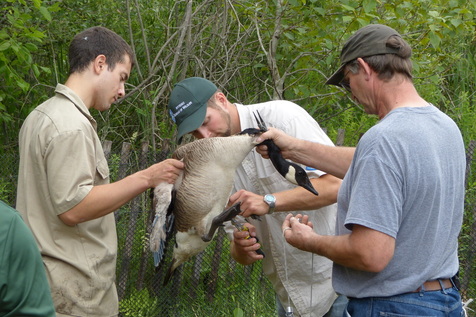
I have always had a love for animals and nature and much of my youth was spent outdoors. After graduating with a B.S. from St. Lawrence University in Canton, NY, I began working as a wildlife technician with the New York State Department of Environmental Conservation based out of Brownville, NY. My main job was working with colonial waterbirds such as Double-crested Cormorants and Caspian Terns but I was lucky enough to work on a variety of projects with a diversity of different wildlife species. However, I realized that waterfowl were my passion so I decided to pursue a M.S. degree at SUNY ESF in Fish and Wildlife Biology and Management. My research will focus on American Black Ducks wintering in the Finger Lakes Region of NY. This involves determining Black Duck habitat selection as well as competition and interactions with Mallards in the hopes of identifying management actions that would benefit Black Ducks.
Justin Droke (MS 2018) (co-advised with Dr. Michael Schummer)
Current Position: Owner, Tristate Timber Consultants, LLC
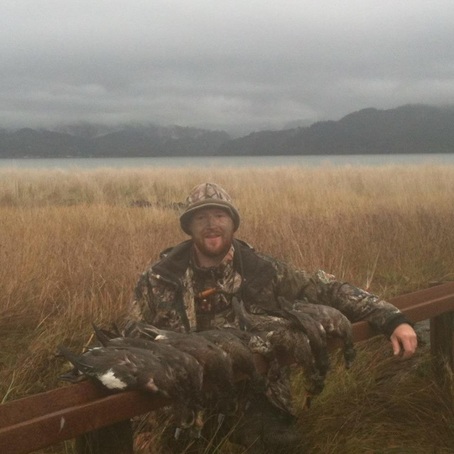
I have been an outdoor enthusiast as long as I can remember. Sitting on my mother’s lap during a dove hunt by the age of two, it’s safe to say I was exposed to what is nature at a young age. Earlier than most, I understood and was intrigued by the idea of land management and conservation. I spent the majority of my youth roaming my family farm observing wildlife and managing the land to attract them. As an avid waterfowl hunter, my interest naturally gravitated to understanding waterfowl ecology and the challenges of managing a migratory species. I began my academic journey participating in organizations such as FFA and 4-H, competing nationally in WHEP (Wildlife Habitat Evaluation Program). As a ‘die hard’ Tennessee fan it was destined that I enter the Wildlife and Fisheries program there. Between football games and serving as president of the wildlife society, I found myself working in the waterfowl lab sorting through core samples for duck foods. The conversations within the lab furthered my interest in pursuing a Master’s degree in wildlife ecology with specific interest in waterfowl.
Currently I am an M.S. student in the Environmental and Forest Biology Department at SUNY-ESF. I am co-advised by Dr. Michael Schummer, (who also holds duties at SUNY-Oswego and Longpoint Waterfowl) and Dr. Jonathan Cohen. My research efforts will focus on non-breeding American Black Duck and Mallard populations wintering in the Finger Lakes Region of central New York. I will equip individuals of both species with backpack transmitters that will allow me to track spring migration trends and techniques, and subsequent settling on breeding grounds. Once the most abundant species in the Atlantic flyway, American Black Duck populations have declined drastically over the past century. I hope to help meet the objectives of the Black Duck Joint Venture, New York Department of Environmental Conservation, and other stakeholders in understanding spring migration of these species and if there are factors related to migration that are limiting to Black Ducks.
Currently I am an M.S. student in the Environmental and Forest Biology Department at SUNY-ESF. I am co-advised by Dr. Michael Schummer, (who also holds duties at SUNY-Oswego and Longpoint Waterfowl) and Dr. Jonathan Cohen. My research efforts will focus on non-breeding American Black Duck and Mallard populations wintering in the Finger Lakes Region of central New York. I will equip individuals of both species with backpack transmitters that will allow me to track spring migration trends and techniques, and subsequent settling on breeding grounds. Once the most abundant species in the Atlantic flyway, American Black Duck populations have declined drastically over the past century. I hope to help meet the objectives of the Black Duck Joint Venture, New York Department of Environmental Conservation, and other stakeholders in understanding spring migration of these species and if there are factors related to migration that are limiting to Black Ducks.

Samantha Mello (MS 2018 (co-advised with Dr. Chris Whipps))
As a child growing up on a farm in Massachusetts, I was always outside digging in the dirt, riding my horses or watching tadpoles metamorphose into frogs in the pond behind our barn. This love of outdoors translated into my school career and, even at grade five, I knew I wanted to do something with conservation. Throughout my undergraduate degree, I studied the success of hand-rearing rhinoceros calves for my honor’s thesis further propelling me down the path of conservation.
After graduating with a B.S. in Environmental Science in 2014, I worked with the Department of Energy and Environmental Protection in Connecticut on the New England cottontail project. We were studying the preferred microhabitats as escape habitat for the New England cottontail, home ranges and survivability through telemetry, trapping and the use of GPS equipped beagles.
Currently, I am an M.S. student in Fish and Wildlife Biology and Management at SUNY-ESF studying under Dr. Jonathan Cohen and Dr. Christopher Whipps working on the New England cottontail project. My research interest is in parasite-mediated competition between the native New England cottontail (Sylvilagus transitionalis) and the non-native Eastern cottontail (Sylvilagus floridanus). I will be looking at ecto- and endoparasites of the two species and comparing the species of parasites found. I will also be conducting tick drags through our sites to determine if there is a difference in species composition or abundance between different habitat types.
As a child growing up on a farm in Massachusetts, I was always outside digging in the dirt, riding my horses or watching tadpoles metamorphose into frogs in the pond behind our barn. This love of outdoors translated into my school career and, even at grade five, I knew I wanted to do something with conservation. Throughout my undergraduate degree, I studied the success of hand-rearing rhinoceros calves for my honor’s thesis further propelling me down the path of conservation.
After graduating with a B.S. in Environmental Science in 2014, I worked with the Department of Energy and Environmental Protection in Connecticut on the New England cottontail project. We were studying the preferred microhabitats as escape habitat for the New England cottontail, home ranges and survivability through telemetry, trapping and the use of GPS equipped beagles.
Currently, I am an M.S. student in Fish and Wildlife Biology and Management at SUNY-ESF studying under Dr. Jonathan Cohen and Dr. Christopher Whipps working on the New England cottontail project. My research interest is in parasite-mediated competition between the native New England cottontail (Sylvilagus transitionalis) and the non-native Eastern cottontail (Sylvilagus floridanus). I will be looking at ecto- and endoparasites of the two species and comparing the species of parasites found. I will also be conducting tick drags through our sites to determine if there is a difference in species composition or abundance between different habitat types.
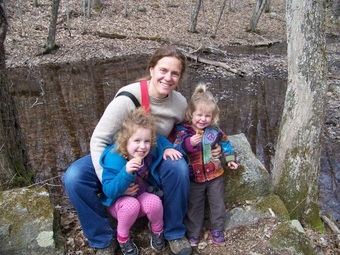
Michelle Peach (Ph.D 2017) (co-advised with Dr. Jacqui Frair)
Current Position: Brightspace Departmental Mentor, University of Rhode Island
According to my parents, the only sure fire way to get me to stop crying as a baby was to take me outside. That love of nature and the outdoors has remained throughout my life and led me first to a B.A. in biology from Carleton College then an M.S. in Land Resource Management at the University of Wisconsin—Madison. I have worked for a variety of non-profit and governmental natural resource organizations doing applied conservation and public communication. Prior to returning to graduate school, I was the Tug Hill Project Director for The Nature Conservancy in northern NY where I was responsible for managing and expanding a protected area network to conserve ecological processes as well as individual species and ecosystems. While thinking about the theoretical and practical aspects of conservation planning, I became interested in the effectiveness of land protection as a long-term conservation strategy given the dynamic nature of natural systems and the potentially accelerating rate of change as a result of climate change.
My Ph.D. research focuses on shifts in avian distributions in response to climate and habitat changes, with a particular interest in the role of protected lands at accelerating or mitigating those shifts. I am using Breeding Bird Atlas data to examine relationships between forest breeding bird distributions and climate, habitat, landscape, and protected area variables at a relatively fine spatial resolution (25 km2 blocks) and broad extent (multiple states) over a twenty year period. I am also exploring methods to analyze BBA data in an occupancy framework despite lacking repeat surveys in each time period.
Current Position: Brightspace Departmental Mentor, University of Rhode Island
According to my parents, the only sure fire way to get me to stop crying as a baby was to take me outside. That love of nature and the outdoors has remained throughout my life and led me first to a B.A. in biology from Carleton College then an M.S. in Land Resource Management at the University of Wisconsin—Madison. I have worked for a variety of non-profit and governmental natural resource organizations doing applied conservation and public communication. Prior to returning to graduate school, I was the Tug Hill Project Director for The Nature Conservancy in northern NY where I was responsible for managing and expanding a protected area network to conserve ecological processes as well as individual species and ecosystems. While thinking about the theoretical and practical aspects of conservation planning, I became interested in the effectiveness of land protection as a long-term conservation strategy given the dynamic nature of natural systems and the potentially accelerating rate of change as a result of climate change.
My Ph.D. research focuses on shifts in avian distributions in response to climate and habitat changes, with a particular interest in the role of protected lands at accelerating or mitigating those shifts. I am using Breeding Bird Atlas data to examine relationships between forest breeding bird distributions and climate, habitat, landscape, and protected area variables at a relatively fine spatial resolution (25 km2 blocks) and broad extent (multiple states) over a twenty year period. I am also exploring methods to analyze BBA data in an occupancy framework despite lacking repeat surveys in each time period.
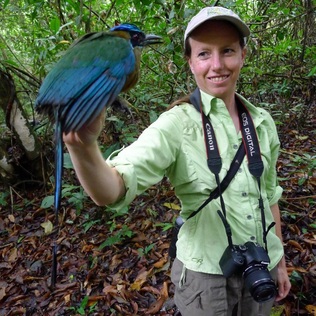
Abigail Darrah, Ph.D. (post-doctoral researcher, 2015-2017)
Current Position: Biologist, Audubon Mississippi Coastal Bird Stewardship Program
As a postdoc at SUNY ESF I am working on a two-year project to develop a decision support tool for the management of the federally threatened Atlantic Coast population of the Piping Plover. An important issue in the conservation of this species is the use of nest exclosures, which increases hatching success but in some situations may increase adult mortality. I am working with land managers and plover biologists to collect coastwide data on plover nest survival along with ecological covariates to better understand this tradeoff. The ultimate goal of this project is to produce a population model that will predict the consequences of exclosure use and other management actions on population growth rate as
a function of site characteristics.
I have a broad range of interests and experiences in ornithology. A native of Ohio, I received both my M.S. and Ph.D. from the University of Arkansas, and moved to New York after a year and a half working as a postdoc at the University of Arizona. For my master’s project I studied the distribution and habitat use of the King Rail in the Mississippi and Illinois River Valleys. For my doctoral project I studied the behavioral and ecological correlates of individual flock-following behavior of a small Neotropical bird, the Wedge-billed Woodcreeper, in Amazonian Ecuador. For my previous postdoc I participated in a number of different projects dealing with the effects of land use, drought, and invasive species management on western bird communities. My interest in ornithology stems from a general passion for nature and travel. In my free time I enjoy training for triathlons, hiking, camping, reading, cooking, and spending time with my husband and dog.
Current Position: Biologist, Audubon Mississippi Coastal Bird Stewardship Program
As a postdoc at SUNY ESF I am working on a two-year project to develop a decision support tool for the management of the federally threatened Atlantic Coast population of the Piping Plover. An important issue in the conservation of this species is the use of nest exclosures, which increases hatching success but in some situations may increase adult mortality. I am working with land managers and plover biologists to collect coastwide data on plover nest survival along with ecological covariates to better understand this tradeoff. The ultimate goal of this project is to produce a population model that will predict the consequences of exclosure use and other management actions on population growth rate as
a function of site characteristics.
I have a broad range of interests and experiences in ornithology. A native of Ohio, I received both my M.S. and Ph.D. from the University of Arkansas, and moved to New York after a year and a half working as a postdoc at the University of Arizona. For my master’s project I studied the distribution and habitat use of the King Rail in the Mississippi and Illinois River Valleys. For my doctoral project I studied the behavioral and ecological correlates of individual flock-following behavior of a small Neotropical bird, the Wedge-billed Woodcreeper, in Amazonian Ecuador. For my previous postdoc I participated in a number of different projects dealing with the effects of land use, drought, and invasive species management on western bird communities. My interest in ornithology stems from a general passion for nature and travel. In my free time I enjoy training for triathlons, hiking, camping, reading, cooking, and spending time with my husband and dog.
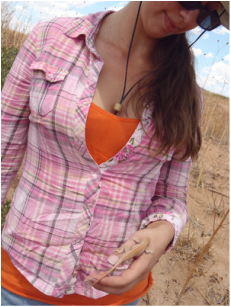
Melissa Althouse (MS 2016)
Current Position: Fish and Wildlife Biologist, US Fish and Wildlife Service
I never even heard of the fields of wildlife biology or conservation management until my sophomore year at Green Mountain College, while a class of mine was ‘testing out’ a prospective new professor. I was instantly hooked. I had always loved wildlife and the outdoors, and finally found a calling where I can simultaneously help and be working in the places I love.
I carried this affection all the way from my home town just minutes from Nantasket Beach, MA, through my undergraduate career in Vermont, a few more choice eastern states, and eventually to southeastern New Mexico before attending SUNY ESF. Some select research topics of mine are the use of mDNA as a tool to study larval fish drift, population dynamics of dunes sagebrush lizard (Sceloporus arenicolus) to determine eligibility for federal listing as an endangered species, and habitat usage by the lesser prairie chicken (Tympanuchus pallidicinctus) in areas of intensive fossil fuel development. I am now studying the effects of disturbance on roseate terns in pre-migratory staging grounds within the Cape Cod National Seashore.
Some of my favorite hobbies are cooking, making art, horseback riding, and doing absolutely anything outdoors with my husband and dog.
Current Position: Fish and Wildlife Biologist, US Fish and Wildlife Service
I never even heard of the fields of wildlife biology or conservation management until my sophomore year at Green Mountain College, while a class of mine was ‘testing out’ a prospective new professor. I was instantly hooked. I had always loved wildlife and the outdoors, and finally found a calling where I can simultaneously help and be working in the places I love.
I carried this affection all the way from my home town just minutes from Nantasket Beach, MA, through my undergraduate career in Vermont, a few more choice eastern states, and eventually to southeastern New Mexico before attending SUNY ESF. Some select research topics of mine are the use of mDNA as a tool to study larval fish drift, population dynamics of dunes sagebrush lizard (Sceloporus arenicolus) to determine eligibility for federal listing as an endangered species, and habitat usage by the lesser prairie chicken (Tympanuchus pallidicinctus) in areas of intensive fossil fuel development. I am now studying the effects of disturbance on roseate terns in pre-migratory staging grounds within the Cape Cod National Seashore.
Some of my favorite hobbies are cooking, making art, horseback riding, and doing absolutely anything outdoors with my husband and dog.
Anand Chaudhary (MS 2014)
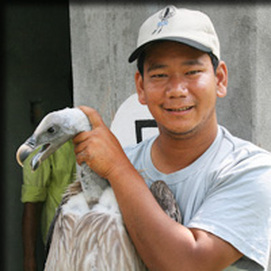
Current Position: Ph.D. Student at Baylor University
I am Anand Chaudhary, MS student of Conservation Biology on a Fulbright Scholarship. I come from an indigenous Tharu community from the lowlands of South-western Nepal. Before joining ESF, I was working for conserving Critically Endangered vulture species in Nepal and across South Asia. I have also worked for joint program of Nepal Government and WWF to conserve tiger and other biodiversity by linking several national parks through biological corridors. I am married and have a daughter.
My MS research, supported by USFWS is on avian diversity and metal contaminants in the Onondaga Lake waste beds near Syracuse, NY. Onondaga Lake is one of the most polluted sites in the United States with a history of over 100 years of industrial and municipal pollution. The lake is in the process of being restored and my research will help understand the use of a heavily polluted area called the ‘waste beds’ by avian community and provide information on the degree of exposure of birds to metal contaminants. I am comparing mercury and chromium in blood of song birds, their invertebrate food source and also avian diversity between Onondaga Lake waste beds and a reference site.
I am Anand Chaudhary, MS student of Conservation Biology on a Fulbright Scholarship. I come from an indigenous Tharu community from the lowlands of South-western Nepal. Before joining ESF, I was working for conserving Critically Endangered vulture species in Nepal and across South Asia. I have also worked for joint program of Nepal Government and WWF to conserve tiger and other biodiversity by linking several national parks through biological corridors. I am married and have a daughter.
My MS research, supported by USFWS is on avian diversity and metal contaminants in the Onondaga Lake waste beds near Syracuse, NY. Onondaga Lake is one of the most polluted sites in the United States with a history of over 100 years of industrial and municipal pollution. The lake is in the process of being restored and my research will help understand the use of a heavily polluted area called the ‘waste beds’ by avian community and provide information on the degree of exposure of birds to metal contaminants. I am comparing mercury and chromium in blood of song birds, their invertebrate food source and also avian diversity between Onondaga Lake waste beds and a reference site.
Laurel Nowak-Boyd (MS 2014)
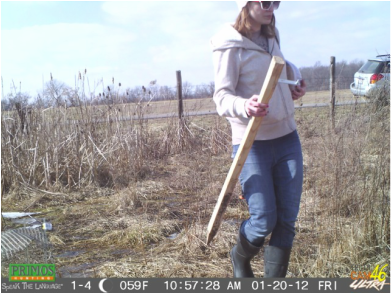
Current Position: Middle and High School Science Teacher, Hillcrest School
My research at SUNY ESF focused on developing monitoring methods for a declining population of Ring-necked pheasants in western New York State. I related population indices obtained by the New York State Department of Environmental Conservation (NYSDEC) through annual crowing-count surveys to absolute estimates of population size obtained through capture-mark-recapture, triangulation-based distance sampling, and Poisson-mixture models; this work aimed to provide a better understanding of the implications of results from crowing-count surveys. Additionally, I developed occupancy models to determine correlations between pheasant distribution and patch- and landscape-level habitat variables. The results obtained in this study will assist NYSDEC in measuring and predicting the effects of management, with the ultimate goal of reversing the population decline and reducing reliance on the state's pen-rearing program to provide hunting opportunities.
I received a BS in Zoology with a concentration in Environmental Biology from Michigan State University in 2010. At MSU I worked as an undergraduate teaching assistant and as a mentor to new students in the biological sciences. I spent the summer following graduation as an intern in the Zoology department of the Field Museum of Natural History, where I assisted in georeferencing specimens in the museum's bird collection, and identifying ectoparasites collected from birds and mammals in Malawi.
My research at SUNY ESF focused on developing monitoring methods for a declining population of Ring-necked pheasants in western New York State. I related population indices obtained by the New York State Department of Environmental Conservation (NYSDEC) through annual crowing-count surveys to absolute estimates of population size obtained through capture-mark-recapture, triangulation-based distance sampling, and Poisson-mixture models; this work aimed to provide a better understanding of the implications of results from crowing-count surveys. Additionally, I developed occupancy models to determine correlations between pheasant distribution and patch- and landscape-level habitat variables. The results obtained in this study will assist NYSDEC in measuring and predicting the effects of management, with the ultimate goal of reversing the population decline and reducing reliance on the state's pen-rearing program to provide hunting opportunities.
I received a BS in Zoology with a concentration in Environmental Biology from Michigan State University in 2010. At MSU I worked as an undergraduate teaching assistant and as a mentor to new students in the biological sciences. I spent the summer following graduation as an intern in the Zoology department of the Field Museum of Natural History, where I assisted in georeferencing specimens in the museum's bird collection, and identifying ectoparasites collected from birds and mammals in Malawi.
